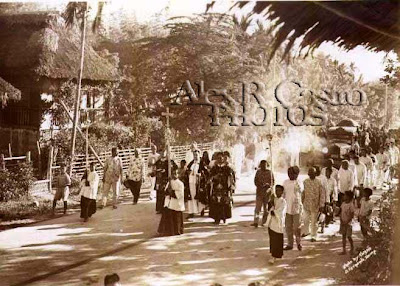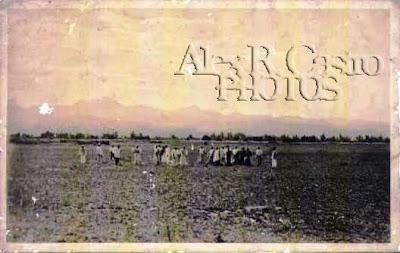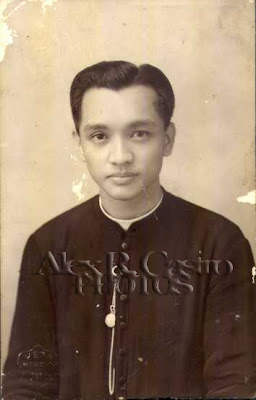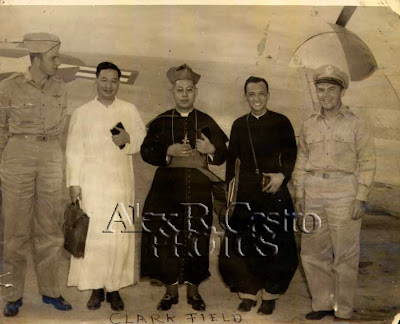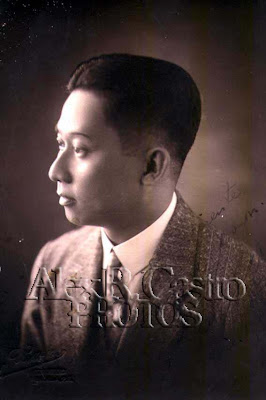 BENIGNO Q. AQUINO SR., (1894-1947) son of Tarlac revolutionary Servillano Aquino, father of Ninoy Aquino, was also a great wartime leader on his own. He became a district representative, assemblyman, senator, a Nacionalista campaign manager and a Secretary of Commerce and Agriculture.Early 1930s.
BENIGNO Q. AQUINO SR., (1894-1947) son of Tarlac revolutionary Servillano Aquino, father of Ninoy Aquino, was also a great wartime leader on his own. He became a district representative, assemblyman, senator, a Nacionalista campaign manager and a Secretary of Commerce and Agriculture.Early 1930s.The Kapampangan hero-martyr, Benigno “Ninoy”Aquino Jr. is a familiar face to many Filipinos, as his smiling bespectacled likeness has been immortalized in almost everything—from postage stamps and 500 peso bills to his rebulto in Makati and in other parts of the country. Indeed, he has even given his name to our international airport. Not too many though are familiar with the achievements of his father, the senior Benigno Q. Aquino, much less his countenance, which was why I had to do a double take on this photo postcard when it was offered for sale in a recent memorabilia auction. I was told by the dealer that the subject was an “Aquino” relative, but since the autograph had faded and had become illegible, he was not quite sure as to the man’s true identity. Luck was on my side as I had just re-read Nick Joaquin’s “The Aquinos of Tarlac” a few days before. Comparing the photos of the book and the postcard, it was easy figuring out that the subjects were one and the same—same full cheeks, same profile, same chinky eyes! I had found a rare real photo postcard of our great wartime leader and Ninoy’s father, Benigno Q. Aquino Sr.!
Benigno Sr. was born in Murcia, Tarlac on 3 September 1894, one of three sons of the revolutionary general Servillano Aquino (Don Mianong) and Guadalupe Quiambao. His siblings included Gonzalo (1893) and Amando (1896). The family moved to Concepcion until 1897 when Don Mianong joined the Revolution against Spain. Benigno was sent off to Angeles to live with his aunts, Brigida and Maria who had married into the Ganzons. Later, he boarded in the school of Don Modesto Joaquin in Bacolor. When Don Mianong came home from the war with the U.S. in 1904, Benigno entered the Colegio de San Juan de Letran. An accomplished student in oratory and philosophy, the 13 year-old Benigno graduated with a Bachelor of Arts degree. He then pursued law at the University of Santo Tomas, completing the course and passing the bar in 1913 at age 18.
Benigno Sr. practiced his profession in Tarlac and it was there that he met and married Maria Urquico in May 1916. Maria, one of the country’s first certified public accountants, was the youngest daughter of an affluent rice merchant and katipunero Antonio Urquico and Justa Valeriano.The couple settled in Murcia, where Benigno ran a thriving sugar business in his own hacienda, and built a reputation as “a lawyer by profession and a farmer by occupation”. They bore 4 children: Antonio, Servillano, Milagros and Erlinda.
Meanwhile, his star as a politician also began to rise. He became Tarlac’s 2nd district representative in 1919-1928. In his first year as Senator (1928-1934), he lost his wife Maria in March 1928. As a young widower, he was linked with two recent Misses Philippines: Luisa Marasigan and Pacita de los Reyes. But when it was time to re-marry, he chose a 3rd cousin who was 16 years his junior—Aurora Aquino, whom he wedded on 6 Dec. 1930. They begat 7 children: Maria Aurora, Benigno Servillano (Ninoy) Jr., Maria Gerarda, Maria Guadalupe, Agapito (Butz), Paul, Maria Teresa (Tessie).
Benigno Sr. became an Assemblyman (1935-1938) and after that stint, was appointed as Secretary of Agriculture and Commerce, where he made his mark as an ardent promoter of Philippine overseas trade, ensuring the upgrade of facilities needed for the efficient disposal of agricultural produce and establishing price control systems. His monthly salary as a secretary was donated to his favorite charities like the Hospicio de San Jose. He also became a successful campaign manager for the Nacionalista Party in 1938.
In the dark days of World War II, Benigno Aquino Sr. was among the members of the puppet Japanese government of Pres. Jose P. Laurel. With the liberation of the Philippines came his arrest and imprisonment at Tokyo’s Sugamo Prison in 1945. There, his health deteriorated and he developed a heart problem. Flown back home a year later, the emaciated Benigno Sr. was arraigned before the People’s Court and charged with treason. He was released provisionally on 11 September 1946, and returned to Concepcion to regain his health. Invigorated, he planned to re-enter politics in 1947 but then-president Manuel Roxas, a close friend, could not support him openly as he had been warned not to associate with so-called “Japanese collaborators” lest he lose the promise of precious U.S. aid for war-torn Philippines.
On 20 December 1947, Benigno Sr. attended the world bantamweight title fight between Manuel Ortiz, the Mexican champion and his kabalen, Tirso del Rosario of Tarlac at the Rizal Stadium. In the ensuing excitement of the 4th round in which Del Rosario was knocked down, Benigno Sr. suffered a fatal heart attack.
Four days later, the charge of treason against him was dismissed by the court. In an emotional eulogy delivered by distinguished statesman Claro M. Recto, he addressed the mistreated leader: “Benigno Aquino! Divine Providence, in claiming jurisdiction over you, has denied human tribunals the right to judge you. The government, in paying homage to you, has cleared you of the calumny heaped upon you without due process of law. And the nation, in associating herself with this demonstration of grief, proclaims that you have served her well…they will remember your splendid achievements and the noble example of your nationalism, virile and blameless, and they will call you a true patriot because you were always a true Filipino”.
Benigno Sr. was born in Murcia, Tarlac on 3 September 1894, one of three sons of the revolutionary general Servillano Aquino (Don Mianong) and Guadalupe Quiambao. His siblings included Gonzalo (1893) and Amando (1896). The family moved to Concepcion until 1897 when Don Mianong joined the Revolution against Spain. Benigno was sent off to Angeles to live with his aunts, Brigida and Maria who had married into the Ganzons. Later, he boarded in the school of Don Modesto Joaquin in Bacolor. When Don Mianong came home from the war with the U.S. in 1904, Benigno entered the Colegio de San Juan de Letran. An accomplished student in oratory and philosophy, the 13 year-old Benigno graduated with a Bachelor of Arts degree. He then pursued law at the University of Santo Tomas, completing the course and passing the bar in 1913 at age 18.
Benigno Sr. practiced his profession in Tarlac and it was there that he met and married Maria Urquico in May 1916. Maria, one of the country’s first certified public accountants, was the youngest daughter of an affluent rice merchant and katipunero Antonio Urquico and Justa Valeriano.The couple settled in Murcia, where Benigno ran a thriving sugar business in his own hacienda, and built a reputation as “a lawyer by profession and a farmer by occupation”. They bore 4 children: Antonio, Servillano, Milagros and Erlinda.
Meanwhile, his star as a politician also began to rise. He became Tarlac’s 2nd district representative in 1919-1928. In his first year as Senator (1928-1934), he lost his wife Maria in March 1928. As a young widower, he was linked with two recent Misses Philippines: Luisa Marasigan and Pacita de los Reyes. But when it was time to re-marry, he chose a 3rd cousin who was 16 years his junior—Aurora Aquino, whom he wedded on 6 Dec. 1930. They begat 7 children: Maria Aurora, Benigno Servillano (Ninoy) Jr., Maria Gerarda, Maria Guadalupe, Agapito (Butz), Paul, Maria Teresa (Tessie).
Benigno Sr. became an Assemblyman (1935-1938) and after that stint, was appointed as Secretary of Agriculture and Commerce, where he made his mark as an ardent promoter of Philippine overseas trade, ensuring the upgrade of facilities needed for the efficient disposal of agricultural produce and establishing price control systems. His monthly salary as a secretary was donated to his favorite charities like the Hospicio de San Jose. He also became a successful campaign manager for the Nacionalista Party in 1938.
In the dark days of World War II, Benigno Aquino Sr. was among the members of the puppet Japanese government of Pres. Jose P. Laurel. With the liberation of the Philippines came his arrest and imprisonment at Tokyo’s Sugamo Prison in 1945. There, his health deteriorated and he developed a heart problem. Flown back home a year later, the emaciated Benigno Sr. was arraigned before the People’s Court and charged with treason. He was released provisionally on 11 September 1946, and returned to Concepcion to regain his health. Invigorated, he planned to re-enter politics in 1947 but then-president Manuel Roxas, a close friend, could not support him openly as he had been warned not to associate with so-called “Japanese collaborators” lest he lose the promise of precious U.S. aid for war-torn Philippines.
On 20 December 1947, Benigno Sr. attended the world bantamweight title fight between Manuel Ortiz, the Mexican champion and his kabalen, Tirso del Rosario of Tarlac at the Rizal Stadium. In the ensuing excitement of the 4th round in which Del Rosario was knocked down, Benigno Sr. suffered a fatal heart attack.
Four days later, the charge of treason against him was dismissed by the court. In an emotional eulogy delivered by distinguished statesman Claro M. Recto, he addressed the mistreated leader: “Benigno Aquino! Divine Providence, in claiming jurisdiction over you, has denied human tribunals the right to judge you. The government, in paying homage to you, has cleared you of the calumny heaped upon you without due process of law. And the nation, in associating herself with this demonstration of grief, proclaims that you have served her well…they will remember your splendid achievements and the noble example of your nationalism, virile and blameless, and they will call you a true patriot because you were always a true Filipino”.








